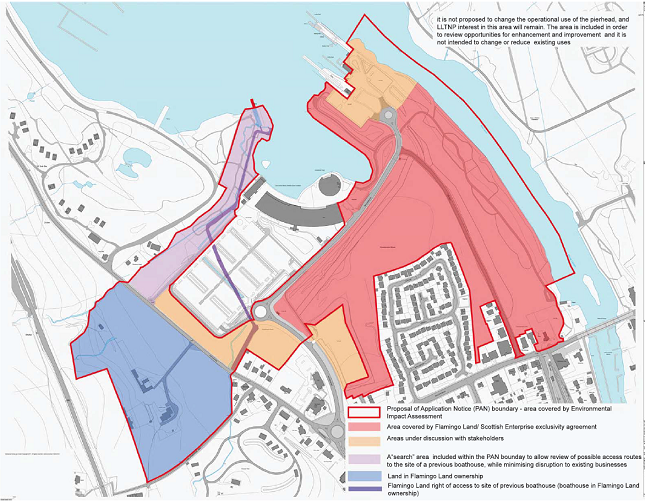
On 27th October, after six months of silence, agents for Flamingo Land lodged a pre-planning application consultation strategy with the Loch Lomond and Trossachs National Park Authority. Anyone who follows Scottish Government planning policy knows that one of the big ideas and big pushes is towards “front loading” the planning system, with a shift to consultation and engagement taking place prior to planning applications being submitted. The idea is this should improve proposals and help create consensus around developments. What front-loading fails to acknowledge is that current planning system is unbalanced, with local communities having little power, and is driven by the self-interest of developers. This, and the pathetic inadequacy of current pre-application consultations are clearly evidenced by the Flamingo Land proposals.
Its still them and us
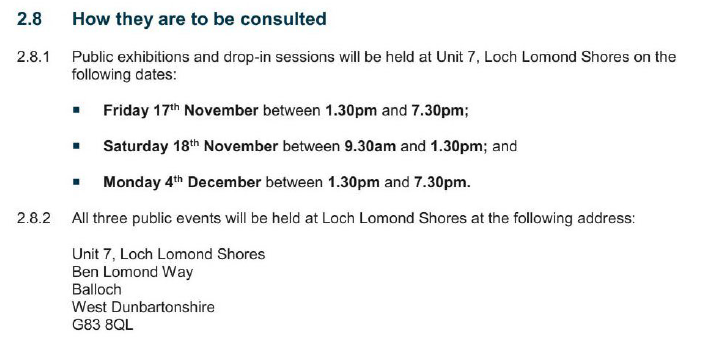
The Pre-application consultation is supposed to include the following:

The only description you will find in the planning documentation about Flamingo Land’s proposals is this:

The LLTNPA will no doubt be patting itself on the back that Flamingo Land is holding three consultation events, rather than the minimum recommended, which is one! How the public are expected to meaningfully inform the proposals by turning up to an event on the day, with little idea of what to expect, and then respond with no time for reflection, I don’t know. Any meaningful consultation has to take place over time, to allow exchange and development of views, but instead of using the last six months to do this, the LLTNPA is allowing Flamingo Land to run three tokenistic events. This is apparently what good consultation looks like – the document states “Best Practice for Consultation is also outlined” – in the planning world. This is a major development proposal in a National Park which has enormous implications both for the local community and the National Park and is quite frankly not good enough.
Its also a recipe for conflict:
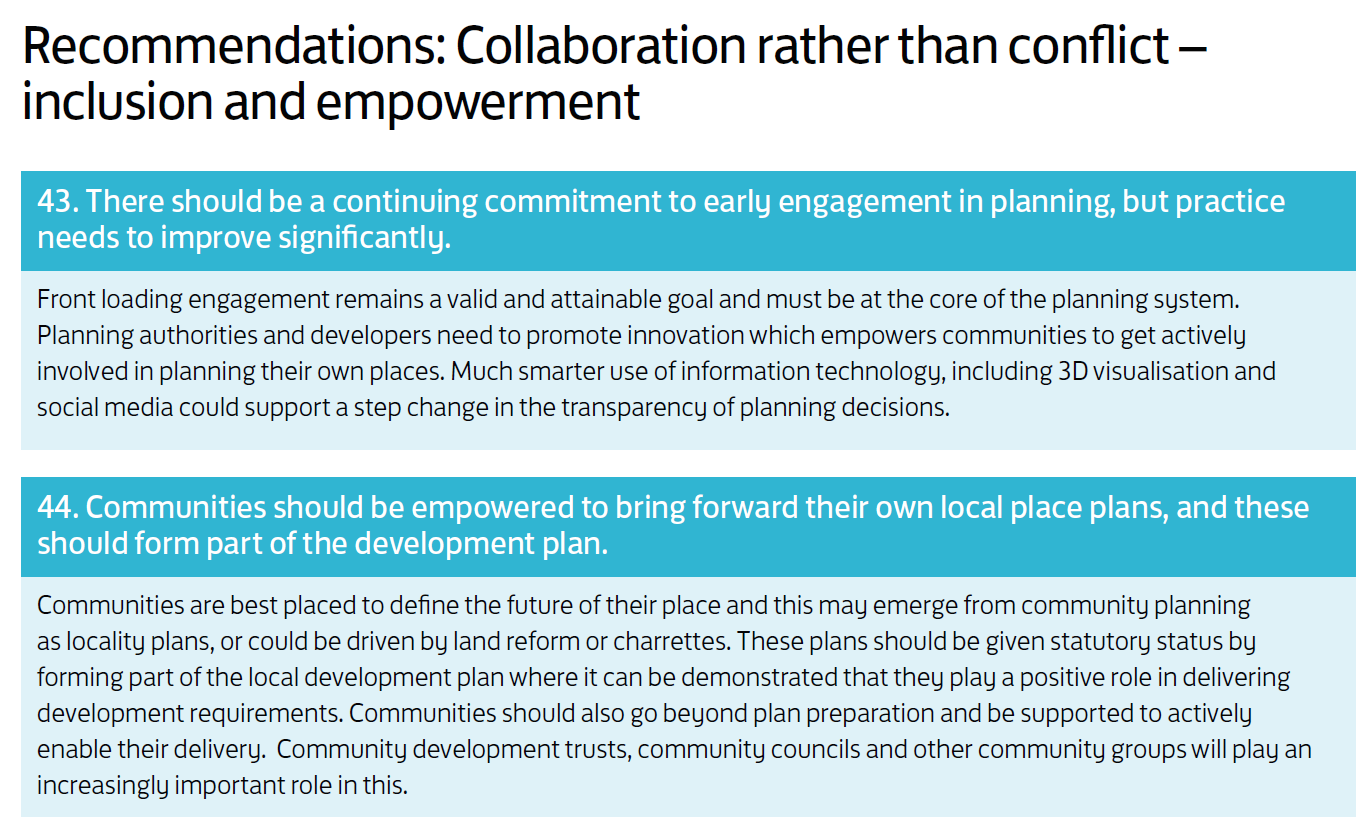
So, why is Petra Biberbach not using her position as Chair of the LLTNPA Planning Committee to empower the local community to get actively involved in planning the Riverside and Woodside sites as she recommended two years ago?
Community Empowerment and planning
While Scottish Government pronouncements and the discourse of our public authorities is full of buzz words about “community engagement”, “community empowerment” and “co-production”, the actions of our Public Authorities continually contradict what is being said. The Park of Weir planning decision, where Planning Minister, Kevin Stewart, overruled the views of the local community at Dunblane in favour of the developers is just one example of this.
Its worth reading what the organisation Planning Democracy had to say about the Scottish Government’s planning white paper (which was developed in response to the review of Planning Petra Biberach was involved in):
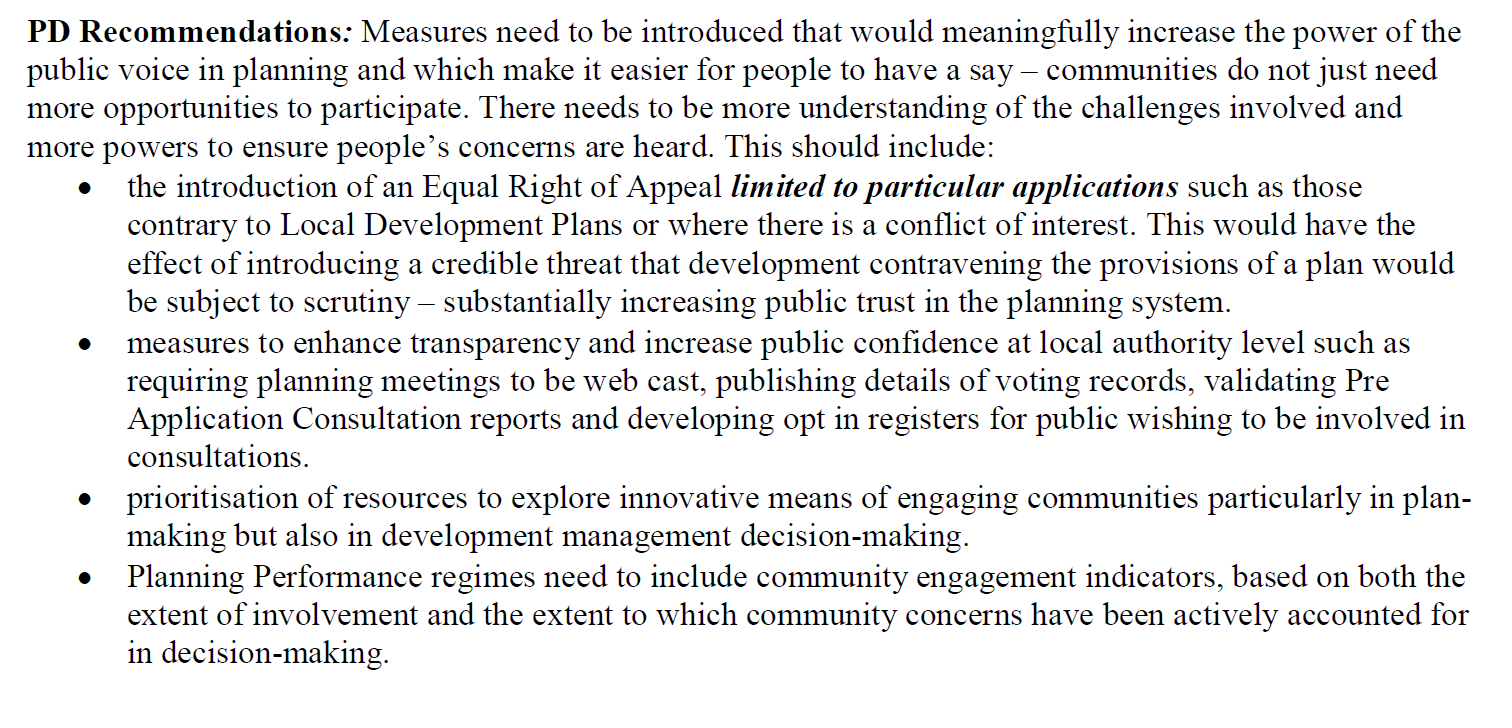 The lack of meaningful involvement however fundamentally comes down to power. What the map above illustrates is that Flamingo Land could be granted a stranglehold over the land to the West of the River Leven and therefore over the local economy. Scottish Enterprise has agreed in principle to sell the Riverside Site, which is currently in public ownership, to Flamingo Land while their purchase of Woodbank House and also the boathouse on the point to the north west of Lomond shores means they surround that development. There are serious issues to be addessed about whether this is in the public or local community interest.
The lack of meaningful involvement however fundamentally comes down to power. What the map above illustrates is that Flamingo Land could be granted a stranglehold over the land to the West of the River Leven and therefore over the local economy. Scottish Enterprise has agreed in principle to sell the Riverside Site, which is currently in public ownership, to Flamingo Land while their purchase of Woodbank House and also the boathouse on the point to the north west of Lomond shores means they surround that development. There are serious issues to be addessed about whether this is in the public or local community interest.
There is, however, now that the Community Empowerment Act is law, an opportunity to challenge this. One way for the local community to prevent Flamingo Land from acquiring too much power would be to request the Riverside site from Scottish Enterprise as an asset transfer. This would not be with a view to stopping all development from going ahead but rather to ensure the community is able to influence the development, retain control in the long-term and ensure some community development. For example, if the local community owned the land they could refuse development in certain places, such as Drumkinnon Wood, prevent inappropriate applications being made in future (e.g viewing towers which I suspect will be the sacrificial lamb Flamingo Land offers up to get their development proposals through) and ensure community benefit through rent payments.
Against what criteria should Flamingo Land’s development proposals be judged?
While the planning application still describes the development as Flamingo Land, the developers have set up a website in the name of Iconic Leisure Developments. This is more informative than the planning application and makes clear that fundamental to the application will be an attempt to “drive the number of visitors”:
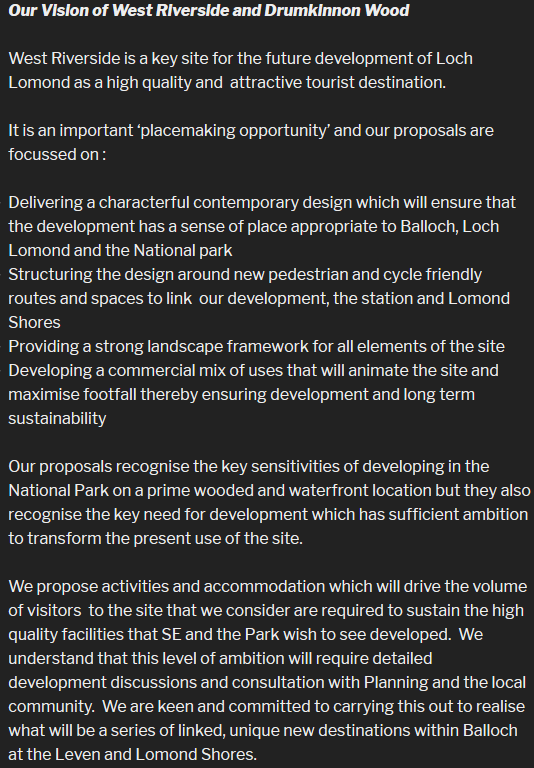
This is worrying. It is exactly the same type of wording which HIE uses at Cairngorm – we all know what happened there – and is, in my view, inappropriate for a National Park.
There is nothing wrong with development at Balloch as long as it is sustainable and benefits both local people and the wider public. While its a gateway to the National Park, gateways are not normally places people choose to linger. People want to get inside and in the case of National Parks to experience nature. It appears the only way Flamingo Land believe they will be able to attract visitors to remain longer term is if they offer a theme park type development. They may be right about this but it would be totally inappropriate for a National Park. The fundamental problem is that this site is being viewed from a commercial, rather than a National Park, perspective and that is likely to drive a certain type of development. Most of it is still public land and other solutions are possible.
Whatever is proposed should, I believe, be evaluated against the National Park’s four statutory objectives. Here are a few pointers of how I think the proposals should be judged:
- Sustainable economic development
- will the long-term jobs on the site be reasonably paid (talk in Scotland is now of £10 an hour minimum wage) and provide good terms and conditions or will the development provide yet more precarious jobs on the minimum wage with precarious hours?
- will local community businesses and other organisations be able to operate within the development area on fair terms and conditions?
- Conservation
- how much of green parts of the Riverside and Woodbank House sites will be retained, will aerial shots of the site look as green in five years time and will Mackinnon Woods be kept free of development?
- what will the landscape impact of the development be and will there be a viewing tower which could be seen from the summit of Loch Lomond
- Sustainable use of resources
- Will any polluted land on the site be cleared up?
- Will the development when operational be powered entirely by renewable energy?
- Will the development result in more traffic and does it incorporate improved public transport links?
- Public enjoyment
- Will traditional informal recreational uses of the site be able to continue (boating and angling on river leaving, walking in Mackinnon Woods)
- Will people visiting site be able to access nature easily, e.g, through a new bridge over the River Leven?
- Will the amount of good quality public space increase or decrease?
This is far from an exhaustive list and other people will have different ideas. The LLTNPA and Flamingo Land should have been engaging with the local community and nationally about such objectives but they haven’t done so so far although they have been clearly having secret talks since January:
 The way its going Flamingo Land should provide an ideal opportunity for both local community and national lobbying organisations to demonstrate to the Scottish Parliament the inadequacies of our current planning system within the forthcoming Planning Bill which is intended to create a different approach.
The way its going Flamingo Land should provide an ideal opportunity for both local community and national lobbying organisations to demonstrate to the Scottish Parliament the inadequacies of our current planning system within the forthcoming Planning Bill which is intended to create a different approach.
Personally I believe the LLNPA is a law unto themselves and proper public consultation etc is not happening as this article proves! It all boils down to money and at the end of the day it’s discusting to let one company co e in here and take over that amount of our green space! Drumkinnon woods are my concern as they are used freely by locals everyday a place to escape from the hustle and bustle that is only going to increase if this project goes ahead and it probably will anyway ! Not to mention the continuing problems with traffic on the A82 , There will be hardly any green space left this side of the Loch, it’s appalling and would be great if the community could have ownership of at least the woods, I believe this will kill Balloch,it will become chaos and destroy parts of our national park not to mention the wildlife trees etc
The West Bank of the Leven will become a concrete jungle if these proposals go ahead. There will be no green areas left in Balloch on the west Loch shore. Balloch Park is a very long walk away from this side of the river if you are not young, fit and healthy. If you are a victim of living in a National Park then planning affecting you is not under democratic control. You are denied what is accepted as a democratic right in the UK. Planning decisions are made by an unelected cabal of appointees from business, landowners and cronies of the Scottish executive. It is a business first model example of the gravy train.
Any developer, I hate the word developer, that attempts to build something on the Bonnie banks and has Flamingo in its title should be regarded with the greatest suspicion. You can be sure this area will be blighted with cheap tat, Blackpool type amusements and lots of noise and litter pollution. Keep what is left of this once beautiful place. Keep the cheap Flamingo tat well away and let nature take over.
Thanks Nick. Barring random protestations, it helps if people are shown how to make an effective formal planning objection directly connected to the MATERIAL CONSIDERATIONS in the LOCAL DEVELOPMENT PLAN. I would focus on the 4 AIMS as you suggest. Otherwise, the Planning Committee will bin the lot. Judging from the exchanges on Facebook it looks like the NP/Flamingo Land’s plan is working so far…the community that was supposed to be “empowered” is in the dark with no clue what to do in planning terms. Of course, this is another area where inequality arises; people in deprived communities can’t afford to hire a solicitor with planning expertise to represent them at Planning Committee meetings. These NP/FLAMINGO LAND people don’t tell the truth…they bury the truth. By the way, I tried Planning Advice Scotland when Petra Biberbach was there. A total waste of space. They had a big fat zero advice to give viz. land use planning and rivers and fisheries. Don’t forget what happened at the last two NP Local Planning Inquiries. I had won an Inquiry into WDC’s Proposed Local Plan and Fisheries Policies were introduced covering the R. Leven up to the Barrage/NP Boundary. Despite all of the talk in support of joined-up and integrated catchment management the NP has consistently refused to consider that for the part of the R. Leven inside of the NP. It’s obvious they don’t want to present me with material grounds to raise objections. Is there a dirty trick they don’t know? Expect extra traffic. I’m going to share a lot of your stuff this week.
Dont let them do it ! The wages thing is a joke they hire and fire according to seasons. Staff have to buy own uniforms and are overworked and undepaid. No loyalty to staff